![]()
![]()
![]()
Use LEFT and RIGHT arrow keys to navigate between flashcards;
Use UP and DOWN arrow keys to flip the card;
H to show hint;
A reads text to speech;
54 Cards in this Set
- Front
- Back
- 3rd side (hint)
|
For what kind of variables is variables sampling used for? |
continuous variables |
|
|
|
what kind of information does variables sampling provide? |
whether a stated amount (balance of account receivables) is materially misstated after the IA has determined the confidence INTERVAL around the sample result that includes the true (but unknown) value at a specified confidence level |
|
|
|
On which four factors does the sample size in classical variables sampling depend? |
- confidence level (i.e. confidence coefficient) - standard deviation of errors in the preliminary sample - population size (number of items in the population) - tolerable error (i.e. materiality) - anticipated error |
|
|
|
What is the formula for sample size for classical variables sampling? |
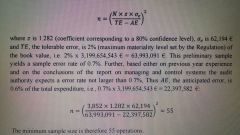
|
|
|
|
What are the 4 statistical sampling methods based on equal probability selection? |
- mean per unit (MPU) - stratified MPU - ratio estimation - difference estimation |
|
|
|
What are the four working steps in MPU and ratio estimation sampling methods? |
- projection of sample error to the population (EE) - calculation of precision (SE) - determination of upper limit of error (ULE = EE + SE) - evaluation: comparison of ULE with maximum tolerable error |
|
|
|
How large is the projected error of the population according to the mean-per-unit estimation method, if a sample of 10 (out of 200) accounts with a recorded amount of $60 (total recorded amount is $2000) is audited, and based on the sample the total amount of the 10 accounts is $50? |
- average error per sample item: ($60-$50)/10=$1 - projected error: 200x$1=$200
|
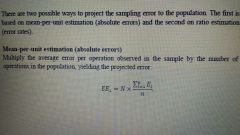
|
|
|
How large is the projected error of the population according to the the ratio estimation method, if a sample of 10 (out of 200) accounts with a recorded amount of $60 (total recorded amount is $2000) is audited, and based on the sample the total amount of the 10 accounts is $50? |
- sample error rate : ($60-$50)/60=16,7% - projected error: 16,7%x$2000=$334 |
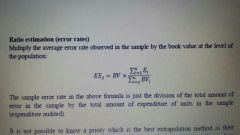
|
|
|
What does MPU project for a population according to Wiley and Gleim? Provide an example for: population size 100, sample size 10, recorded amount of the samples 1000, audited amount of the samples 1500 |
a total dollar value for a population projected population value (1500/10)*100=15000 |
|
|
|
What does ratio estimation project for a population according to Wiley and Gleim? Provide an example for: population's recorded value 10000, sample size 10, recorded amount of the samples 1000, audited amount of the samples 1500 |
a total dollar value for a population (1500/1000)*10000= 15000 |
|
|
|
When can the decision be made in the sampling process which projection method to employ? |
after the sample is selected and audited |
|
|
|
What is the formula for achieved precision in classical variables sampling? |
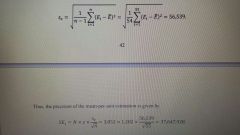
|
|
|
|
How is the upper limit of error (ULE=EE+SE)) compared with the maximum tolerable error (TE)? |
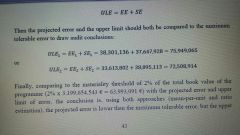
|
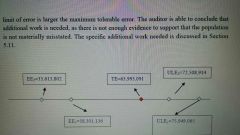
|
|
|
What is a stratified MPU estimation? |
MPU estimation based on a group of items that was separated from the total population due to the group's lesser variability than in the whole population |
|
|
|
Which criteria are appropriate for stratification in variables sampling? |
generally all variables that may explain the level of error in the population (especially monetary values) |
|
|
|
What is the stratified MPU good for? |
to increase audit efficiency by reducing the variability within each group and allowing for a smaller overall sample size |
|
|
|
According to Wiley, to which stratum should the largest portion of the overall sample size be allocated in simple random sampling? |
to the stratum with the largest standard deviation |
|
|
|
According to EU Commission, to which stratum should the largest portion of the overall sample size be allocated in simple random sampling? |
to the stratum with the largest population |
|
|
|
How large is the projected error of the population according to the difference estimation method, if a sample of 10 (out of 200) accounts with a recorded amount of $60 (total recorded amount is $2000) is audited, and based on the sample the total amount of the 10 accounts is $50? |
- average error per sample item: ($60-$50)/10=$1 - projected error: 200x$1=$200 |
|
|
|
What are the 4 working steps according to the difference estimation method after the projection of the sample error to the population to evaluate the sample results? |
- projection for the correct book value (CBV) - calculation of precision (SE) - calculation of the lower limit (LL=CBV-SE) - comparison of CBV and LL with BV-TE |
|
|
|
How are the correct book value (CBV) projected and the precision (SE) calculated? |
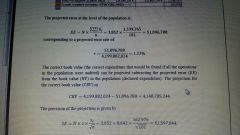
|
|
|
|
Which 4 factors do affect the size of the achieved precision and how do they affect it if these factors are increased? |
- the larger the confidence level (i.e. confidence coefficient), the higher the achieved precision - the larger the sample errors' standard deviation, the higher the achieved precision - the larger the population's size, the higher the achieved precision - the larger the sample size, the lower the achieved precision |
|
|
|
What can be concluded from the comparison of the corrected book value (CBV) and the lower limit (LL) with the book value (BV) reduced by the tolerable error (TE)? |
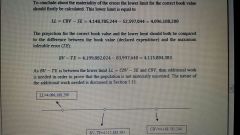
|
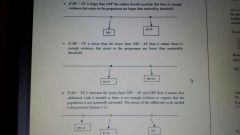
|
|
|
What does difference estimation project for a population according to Wiley and Gleim? Provide an example for: population's recorded value 10000, populations size 100, sample size 10, recorded amount of the samples 1000, audited amount of the samples 1500 |
the estimated correct value of the population error per sample item (1500 - 1000)/10=50 projected error 50 * 100=5000 estimated correct population value 10000+5000=15000 |
|
|
|
If the corrected book value (CBV) is 1000, the calculated precision is 100, and the confidence level 95%, what is the probability that the true (but unknow) value is lower than 900 or higher than 1100? |
2,5% in each case =(100%-95%)/2
|
|
|
|
Which precision limit (upper or lower limit) is an IA concerned about in variables sampling? |
upper and lower limit (a receivables balance can be either over- or understated) |
|
|
|
If the sample mean per sampled inventory is $52 and the achieved precision per unit is $1.03, what is the estimated inventory value for 20,000 inventory item? Is the estimated value within the desired precision of 2%? |
confidence interval of estimated inventory value: 20,000x(52+-1.03)= $1,019,400 and 1,060,600 achieved precision: $1,03/$52=1,98% < 2% |
|
|
|
How does monetary-unit sampling (MUS) work? |
- the sampling unit is a unit of money ( a HOMOGENOUS unit) rather than an invoice or an account - an item (invoice, account, etc.) containing the specific monetary unit is selected for testing |
|
|
|
What are the advantages of MUS?(2) |
- efficient sampling model for establishing that a low error rate population is not materially misstated - does not require the normal distribution approximation required by variable sampling |
|
|
|
Which method of sample selection is used for MUS? |
systematic sample selection method with probability proportional to size |
|
|
|
How is MUS called as well? |
probability-proportional-to-size (PPS) |
|
|
|
How large must the error rate in the population maximally be so that using MUS is still efficient? |
10% |
|
|
|
On which five factors does the sample size for MUS depend (according to EU commission)? |
- confidence level (i.e. confidence coefficient) - population book value - standard-deviation of error rates produced from a MUS sample - maximum tolerable error - anticipated error |
|
|
|
According to Gleim, on what does the sample size for MUS NOT depend? |
standard deviation of the book values or of the errors in the populaton |
|
|
|
What is the formula for MUS sample size? |
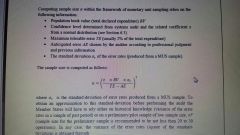
|
|
|
|
How is the cut-off value for the high-value stratum in MUS determined in which all samples are audited? |
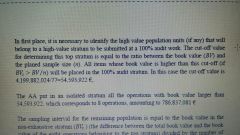
|
|
|
|
Which sample selection method is used for MUS? |
systematic selection |
|
|
|
How is the sampling interval in MUS determined? |
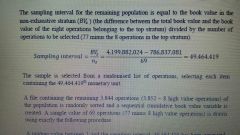
|
|
|
|
How must the population be arranged so that MUS can be used? |
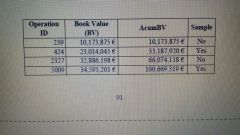
cumulatively |
|
|
|
How are the first and the second sample items in MUS selected? |
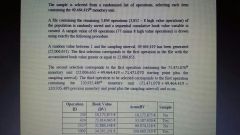
|
|
|
|
How is the projected error at the level of population calculated in MUS? |
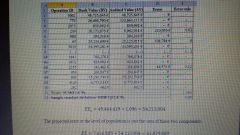
|
49,464,419 = sampling interval 7,616,805 = total error amount in the high-value stratum (exhaustive stratum) |
|
|
How is precision calculated in MUS ? |
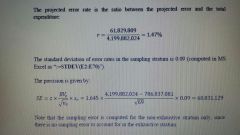
|
|
|
|
How are the sampling results evaluated in MUS? |

|
|
|
|
For which variables sampling methods must the recorded book value of the population items be known? |
- ratio estimation - difference estimation - MUS - according to Gleim not for MPU (according to EU Commission book values are needed in MPU as well to calculate the error for each sample item) |
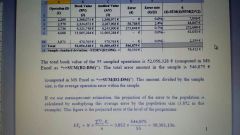
|
|
|
When should unstratified MPU be used?(2) |
- when only a few errors in the population are expected - when there is an expectation that errors are relatively independent from the level of book values (higher errors can be found either in units of high or low level of book values) |
|
|
|
When may MPU sampling be difficult? |
in an unstratified sampling situation |
|
|
|
Which sampling methods are used when estimating dollar amounts of errors for normally distributed population? |
Difference or ratio estimation |
|
|
|
When should ratio estimation be used?(3) |
- errors can be found in the whole population(errors are not skewed) - book values are highly variable - when errors are proportional to book values (higher value items tend to exhibit higher errors) |
|
|
|
When is difference estimation useful?(4) |
- when it is intended to project the correct balance in the population - errors can be found in the whole population (errors are not skewed) - if the book values tend to be similar (low variability of book values) - if the level of error is relatively constant in the population (errors are not proportional to book values) |
|
|
|
When is difference estimation preferable to ratio estimation? |
- when errors are not proportional |
|
|
|
When are ratio estimation and difference estimation not efficient? |
When only a few differences between recorded and observed amounts (errors) arefound |
|
|
|
When is MUS appropriate?(3) |
- when some items in account balances may be far larger (overstated) than others in the population (high variability of book values) - when there is positive correlation between errors and book values - when only a few errors are expected |
|
|
|
When is MUS inefficient? |
many misstatements (overandunderstatements) are expected |
|
|
|
Which sampling methods are efficient if a high degree of variability in book values within the population prevails?(2) |
- ratio estimation - MUS |
|

